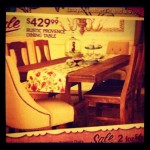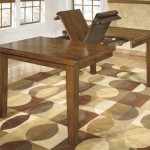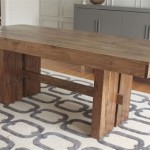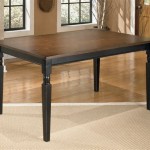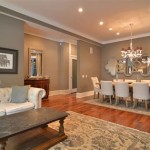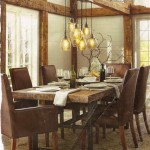How To Decorate a Living Room and Dining Room Combo
Many contemporary homes feature open-concept designs, frequently combining the living room and dining room into a single, multi-functional space. Decorating this combo presents both opportunities and challenges. The goal is to create a cohesive design that allows each area to maintain its distinct identity while contributing to an overall harmonious aesthetic. This requires careful planning and thoughtful execution in terms of layout, color palette, furniture selection, and accessories.
The successful integration of a living room and dining room relies on establishing a unified theme that ties the two spaces together. This theme might stem from a particular design style, such as modern, minimalist, farmhouse, or bohemian. Alternatively, it can be based on a specific color scheme or textural element that is consistently applied throughout both areas. Before embarking on any decorating project, it's crucial to define this unifying element to ensure a cohesive and visually appealing result.
Defining Zones and Spatial Arrangement
Despite the open layout, it's essential to clearly define the living and dining areas within the shared space. Failing to do so can result in a disorganized and visually cluttered environment. Several techniques can be employed to achieve this spatial separation.
One effective method is the strategic placement of furniture. A large sofa or sectional can act as a natural divider between the living and dining zones. Positioned with its back facing the dining area, it creates a psychological boundary that delineates the two spaces. Similarly, a console table placed behind the sofa can further reinforce this division, providing a surface for lamps, decorative objects, or even a small bar area.
Rugs are another powerful tool for defining zones. A large area rug in the living room anchors the seating arrangement and visually separates it from the dining area. Similarly, a rug under the dining table defines the eating space and creates a sense of visual cohesion within that zone. The rugs don't necessarily need to match, but they should complement each other in terms of color, pattern, or texture to maintain a sense of harmony.
Architectural elements can also be incorporated to subtly define the zones. A change in flooring, such as transitioning from hardwood in the living room to tile in the dining area, can visually separate the spaces. A partial wall or decorative screen can also serve as a divider without completely closing off the areas. Consider incorporating built-in shelving, which can offer both storage and visual separation.
Lighting plays a crucial role in defining zones and setting the mood in each area. The living room typically benefits from softer, ambient lighting, such as table lamps, floor lamps, and dimmable overhead fixtures. In contrast, the dining area requires brighter, more focused lighting, such as a chandelier or pendant light directly above the dining table. Utilizing different types of lighting in each zone helps to emphasize their distinct functions and creates a more layered and inviting atmosphere.
Selecting a Unifying Color Palette and Style
The color palette serves as the foundation for a cohesive design in a living room and dining room combo. Choosing a limited number of colors and repeating them throughout both spaces creates a sense of unity and visual harmony. The palette should consider the existing architectural features, the amount of natural light available, and the desired mood.
Neutral colors, such as white, gray, beige, and greige, are excellent choices for creating a versatile and timeless foundation. These colors provide a blank canvas that can be easily accented with pops of color in the form of throw pillows, artwork, and accessories. Neutral walls also help to maximize natural light and make the space feel larger and more open.
Accent colors can be incorporated to add personality and visual interest. These colors should be used sparingly to avoid overwhelming the space. Consider choosing two or three accent colors that complement each other and the neutral base. For example, a palette of gray, white, and navy blue can create a sophisticated and calming atmosphere, while a palette of beige, cream, and coral can evoke a warmer and more inviting feel.
Consistency in style is also vital for creating a cohesive look. Whether the chosen style is modern, traditional, or eclectic, it should be consistently applied throughout both the living and dining areas. This doesn't mean that every piece of furniture needs to match perfectly, but they should share similar characteristics in terms of form, material, and finish. For example, if the living room features clean-lined furniture with minimalist details, the dining room should also incorporate pieces with a similar aesthetic.
Consider the architectural style of the home when selecting the overall design. A traditional home might benefit from a more formal and elegant approach, while a modern home might lend itself to a more streamlined and contemporary aesthetic. The goal is to create a space that feels authentic and reflects the overall character of the home.
Furniture Selection and Arrangement for Optimal Functionality
Furniture selection is a critical factor in creating a functional and aesthetically pleasing living room and dining room combo. The furniture should be appropriately sized for the space and arranged in a way that maximizes flow and encourages conversation.
In the living room, the seating arrangement should be conducive to socializing and relaxation. A sofa or sectional is typically the focal point, and it should be complemented by comfortable chairs or armchairs. The seating pieces should be arranged to facilitate conversation, with a coffee table placed in the center to provide a surface for drinks and snacks. Consider incorporating ottomans or poufs for added comfort and flexibility.
In the dining room, the dining table is the central element. The size of the table should be appropriate for the size of the room and the number of people who typically dine there. Choose chairs that are comfortable and stylish, and consider adding a sideboard or buffet for storage and serving. A rug under the dining table helps to define the space and adds a touch of warmth and texture.
When selecting furniture for a living room and dining room combo, it's important to consider the overall proportions of the space. Avoid overcrowding the room with too much furniture, as this can make it feel cramped and cluttered. Instead, opt for fewer, larger pieces that make a statement and create a sense of spaciousness. Multipurpose furniture should be prioritized where possible.
Consider the flow of traffic between the two zones when arranging the furniture. Ensure that there is ample space for people to move freely without bumping into furniture. The layout should also facilitate easy access to the kitchen and other areas of the home. A well-planned layout will make the space feel more comfortable and functional, and it will enhance the overall enjoyment of the living room and dining room combo.
Scale and proportion play a vital role in any interior design project, but they are particularly important in a combined living and dining space. Mismatched scales, such as an oversized sofa in a small living area or a miniature dining table in a vast space, will throw off the balance and harmony of the entire room. Pay close attention to the dimensions of each piece of furniture relative to the size of the room. Before purchasing anything, measure the space and tape out the dimensions of the furniture on the floor to visualize how it will fit. This will help you avoid making costly mistakes and ensure that the furniture is appropriately sized for the space.
The choice of materials can also significantly impact the overall aesthetic and functionality of the living and dining room combo. Consider the durability, texture, and visual appeal of the materials when making your selections. For example, natural materials such as wood, stone, and leather can add warmth and character to the space, while more modern materials such as glass, metal, and concrete can create a sleek and contemporary look. Mixing and matching different materials can add visual interest and depth to the design, but it's important to maintain a sense of balance and harmony. For instance, combine a plush velvet sofa with a sleek glass coffee table, or pair a rustic wooden dining table with modern metal chairs.

Living Room And Dining Design Ideas Designcafe

Living Room Dining Combo Ideas With Tricks Doğtaş

Living Room And Dining Design Ideas Designcafe

Living Room Dining Combo Ideas With Tricks Doğtaş

Living And Dining Room Combo With 5 Illustrated Floor Plans Roomlay

5 Tips For Decorating A Combined Living Dining Room Happily Ever After Etc Layout Rectangular Rooms Combo

36 Living Room Dining Combo Ideas To Transform Your Home

90 Minute Interior Design Consultation From Designed To Sell 50 Off Living Room Dining Combo Small Apartment

Small Living Dining Room Combo Ideas Transformer Table

Star Furniture

